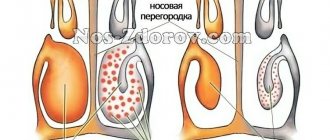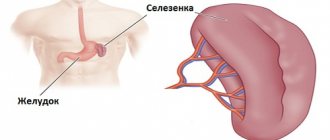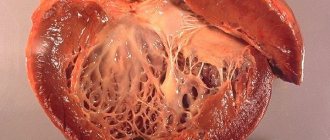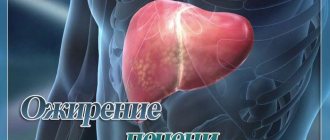Erythrocytosis is a certain pathological condition of the body, which is characterized by an increase in the number of red blood cells and hemoglobin in the bloodstream. The presence of erythrocytosis in a person can be indicated when red blood cells increase from 6 T/l and hemoglobin - from 170 g/l.
It is important to understand that erythrocytosis is an indicator of a pathological process. In its own way, erythrocytosis is a kind of “mirror of pathology”, because most often it appears as an adaptive function of the body to certain pathophysiological processes. In addition, erythrocytosis can become a manifestation of tumor processes or chronic hypoxia and may be their only manifestation. Therefore, you need to know all the manifestations of this condition and the reasons that can cause it. This is necessary for its timely detection and treatment, which must be done before irreversible damage occurs in the body.
Erythrocytosis causes
The causes of erythrocytosis are varied.
Physiological erythrocytosis is distinguished, the occurrence of which is due to physiological changes in the body. This includes erythrocytosis in residents of high mountains. The fact is that in such areas the oxygen content in the air is reduced; it enters the body in less quantity than it needs. Automatically, the body produces more red blood cells than normal. Physiological erythrocytosis develops. In this way, he tries to “grab” as much oxygen as possible with red blood cells: the process of hypoxia triggers the release of erythropoietin by the kidneys and activates the formation of red blood cells in the bone marrow.
It is important to note that this process is not instantaneous, but develops gradually, as an adaptive function of the body to hypoxia. Therefore, it is necessary to look for erythrocytosis in those who have lived a fairly large amount of time in rarefied air conditions.
Physiological erythrocytosis is also observed in newborns. Since the child received maternal blood in the womb, in which the percentage of oxygen was much less than its percentage in the air. Therefore, at birth the baby has a higher number of red blood cells than in a similar analysis, for example, 2-3 days after birth.
In addition to physiological, two more types are distinguished: absolute erythrocytosis and relative.
Absolute erythrocytosis occurs due to increased erythropoietic function of the bone marrow. It can be stimulated by chronic lung diseases (such as COPD, emphysema, blue congenital heart defects: tetralogy of Fallot).
Relative erythrocytosis is an increase in the number of red blood cells and hemoglobin per unit volume of blood, due to a deficiency in plasma volume. A striking example of relative erythrocytosis is blood loss, a decrease in the volume of circulating fluid during vomiting, massive diarrhea.
There are primary and secondary erythrocytoses
The causes of primary erythrocytosis are genetic defects, due to which red blood cells more difficultly release oxygen to tissues. Genetic defects appear in globin, an integral part of the hemoglobin molecule, or the content of a special regulator in red blood cells, which is responsible for its oxygenation and deoxygenation (“loading” and “unloading” of oxygen in red blood cells), is disrupted. As a result, the affinity of hemoglobin for oxygen increases and its delivery to tissues worsens. Hemic hypoxia of the body develops, which stimulates the release of erythropoietin by the kidneys, which stimulates erythropoiesis in the red bone marrow.
Symptoms
Erythrocytosis occurs in the same way in women and men. In the first stages, the disease does not detect itself and is asymptomatic. Pathology can be detected accidentally using a blood test. With further development of erythrocytosis, the symptoms become pronounced. These include:
- skin redness;
- formation of blood clots, blockage of blood vessels;
- increased blood pressure;
- disturbances in the functioning of the heart;
- headache;
- increase in the size of the liver and spleen;
- staining of nails, fingers and the tip of the nose bluish (during hypoxia);
Long-term absence of treatment is fraught with progression of the disease and its transition to the anemic stage. In this case, the bone marrow is replaced by connective tissue, and the level of blood cells decreases. In this case, the following signs are observed:
- development of anemic syndrome with dizziness, fainting, pale skin;
- weight loss, physical exhaustion;
- development of hemorrhagic syndrome;
- weakness, drowsiness, decreased performance.
A general or biochemical blood test can help detect elevated levels of red cells. To establish the cause of the disease, an ultrasound of the internal organs, an examination of the cardiovascular system, and fluorography are performed.
Symptoms can be divided into several complex phenomena depending on the stage of the disease.
At the initial stage:
- A slight increase in the size of the spleen, determined by palpation;
- Bone marrow panmyelosis;
- The vessels remain normal.
The initial stage may last several years and may not show symptoms for a long time.
The second stage is characterized by:
- Development of thrombosis;
- Weight loss, physical exhaustion;
- Detection of basophil cells;
- Detection of urea in the blood.
Often it is at this stage that erythrocytosis is detected in a patient.
The third stage is characterized by the following symptoms:
- Enlargement of the spleen and liver, noticeable on palpation;
- Presence of lesions in the red bone marrow;
- Exhaustion of the body, weakness, drowsiness.
In addition, there are symptoms common to all stages - fainting and dizziness, frequent thromboses that are difficult to treat, nosebleeds and headaches.
Erythrocytosis secondary
Secondary (symptomatic erythrocytosis) includes erythrocytosis that arose as a consequence of other diseases.
Secondary erythrocytosis is also divided into relative and absolute. Secondary absolute erythrocytosis includes conditions due to which, as a result of more active erythropoiesis or release into the vascular bed from the bone marrow, the number of red blood cells per unit volume of blood increases.
The cause of secondary absolute erythrocytosis can be various conditions. For example, diseases accompanied by ischemia or tumor lesions of the kidneys, resulting in a large release of erythropoietin, which will stimulate the creation of new red blood cells in the red bone marrow.
Situations accompanied by renal ischemia can result from kidney cysts, various inflammations, stenosis of the renal arteries, and hydronephrosis. Tumor lesions of the kidneys that will lead to increased production of red blood cells include kidney hypernephroma, nephroblastoma, and erythropoietin-secreting tumors. In addition, an increased number of red blood cells can be caused by kidney transplants and blood transfusions of athletes.
Also, various disorders of neurohumoral regulation can lead to erythrocytosis, in which the sympathetic nervous system will be excited.
In addition, increased production of hormones can also lead to increased production of erythropoietin. This is explained by the fact that thyroid hormones, adrenocorticotropic hormones, catecholamines and glucocorticoids increase the utilization of oxygen by the body. And the further pattern of the body’s reaction to a decrease in oxygen in it is quite predictable: in response to hypoxia, erythropoietin will be released into the blood, followed by an increase in the number of red blood cells. This also includes taking androgenic steroids as doping to increase muscle mass.
An important example in absolute secondary erythrocytoses are those that appear as a result of tumor diseases of the red line of hematopoiesis in the bone marrow. A striking example of these diseases is true erythremia or Vaquez disease. It is characterized by significant erythropoiesis: the number of red blood cells in the blood of such patients can increase 7-10 times the norm.
One of the most striking reasons, of course, is the influence of hypoxia and lung diseases on the appearance of symptomatic erythrocytosis. There are hemic, respiratory, circulatory and tissue hypoxia.
With hemic hypoxia, erythrocytosis will develop as a result of a decrease in the oxygen capacity of the blood. As an example, poisoning with carbon monoxide and nitro compounds is suitable.
Circulatory hypoxia induces erythropoiesis due to insufficient pumping function of the heart and insufficient blood supply to tissues and organs. A striking example of this type of hypoxia is heart failure.
Respiratory hypoxia is a consequence of various diseases of the pulmonary system, as a result of which the volume of alveolar ventilation decreases. Examples are: bronchial asthma, chronic bronchitis, various chronic pulmonary diseases.
Tissue hypoxia will result from decreased biological oxidation. It can occur as a result of the progression of any of the above-described hypoxia.
Erythrocytosis of secondary origin can also occur during exogenous hypoxia of the hypobaric and normobaric type. With normobaric hypoxia, the body does not receive oxygen from the air, at normal barometric pressure in the environment. As an example, we can cite cases where a person spends a long time in a small space with poor air flow (closet, elevator, shaft). In the hypobaric type, an increase in the number of red blood cells is obtained due to a decrease in barometric pressure itself. A prime example is decompression sickness.
Relative erythrocytosis of secondary origin includes hemoconcentrating and redistributive forms. Hemoconcentrative erythrocytosis occurs due to loss of water from the vascular bed. Example: strong sweating by a person when working at high temperatures, prolonged thirst, vomiting and diarrhea in infectious diseases, consequences of burns, ketoacidotic coma in patients with diabetes, ulcerative skin lesions.
Redistribution forms are formed when, under various stressful situations, red blood cells that were previously found in depositing organs and tissues are suddenly released into the circulating blood.
One of the most interesting causes of symptomatic erythrocytosis is Gaisbeck syndrome (Gaisbeck disease). It is characterized by a combination of erythrocytosis with arterial hypertension. The reasons for its occurrence are unknown. There are theories about a hereditary predisposition to the disease.
How to reduce hemoglobin levels to normal
Knowing the negative consequences of high levels of this protein, you need to be aware of how to lower hemoglobin in the blood. It is necessary to remove the reasons that led to the increase in this indicator. For a quick result, when the symptoms of deteriorating health are already clearly expressed, you need to consult a doctor and select medications for effective treatment. But the specialist, when asked what to do with high hemoglobin, should focus on the patient’s lifestyle and on preventing the normal level of red cells.
It is necessary to establish a drinking regime and be very attentive to the quality of the water consumed. If it contains a high concentration of chlorine, such a liquid will not thin the blood, but will cause an increase in the number of red blood cells. It is good for normal sweating to drink compotes and juices without sugar, but mainly it should be high-quality purified drinking water without gas.
Your diet should include more natural fruits and vegetables rich in fiber. The latter is necessary for normal digestion of food in the intestines, because if this process is disrupted, the body accumulates toxic substances and gradually self-poisons. In response, the bone marrow produces more red blood cells to replenish oxygen levels.
To bring the level of iron-containing protein back to normal, the following foods should be excluded from the diet:
- red meat;
- liver;
- buckwheat;
- vegetables, fruits and red berries, including black currants and pomegranates.
It is necessary to limit the consumption of fatty and sweet foods as much as possible: sugar helps the blood absorb iron, and fats raise cholesterol levels, which aggravates the risk of blockage of blood vessels. For people with elevated levels of iron-containing protein, walking, swimming, and physical activity are recommended, which will restore proper bone marrow function. When red blood cells are higher than normal, the use of vitamin complexes containing iron, copper, vitamins B and C is prohibited.
Erythrocytosis symptoms
Symptoms of erythrocytosis mainly depend on its type and are quite varied. For example, the color of the skin in patients with an absolute increase in red blood cells will be plethoric - red. In relative forms, the skin color is usually not changed. Also, in both forms, upon objective examination, no enlargement of the spleen is observed.
With cyanotic variants of erythrocytosis, the clinical picture in patients will be dominated by cyanosis of the skin, which will intensify in a supine position. All erythrocytosis associated with kidney damage will most likely be combined with high arterial hypertension.
With hereditary causes of an increase in the number of red blood cells, an erythrocyanotic coloration of the skin will be observed - red with the presence of cyanosis (since the body tolerates hypoxia and contains a large number of red blood cells in the bloodstream). Also, this variant will manifest itself in patients from childhood.
With Vaquez disease, the patient will have characteristic symptoms: bright red coloration of the face and skin; skin itching after bathing procedures and pathological enlargement of the spleen.
It is important to know that in acquired forms the number of red blood cells is increased, as a consequence of the body’s compensatory reactions. Therefore, most often, when the factor that caused the disease is normalized, secondary erythrocytoses disappear.
Headaches and neurological symptoms due to cerebral causes are also possible. Fatigue, drowsiness, and weakness may appear as a response to increased blood viscosity and tissue hypoxia. There is a risk of blood clots.
To determine this or that form of the disease, you need to conduct some laboratory tests:
— Study of a general blood test: the level of red blood cells in men and women
— Determination of erythropoietin levels in blood serum
— Study of blood gas composition
— Ultrasound examination of the kidneys
— Intravenous pyelography
— Measurement of hematocrit and hemoglobin levels
— Ultrasound examination of the heart and blood vessels
— Determination of the level of reticulocytes (young precursors of red blood cells) in the blood
— Determination of the number of platelets and white blood cells (for differentiation with Vaquez disease)
Video: the dangers of increased hemoglobin and red blood cells in the blood
How to assume that you have thick blood and prevent pathologies associated with high levels of red blood cells? In our video, experts will clearly explain how the coagulability of the main biological fluid of the body depends on age and genetic factors, what diet is recommended for high hemoglobin, and talk about the features of using medications to reduce the level of red blood cells:
Low hemoglobin levels are more common among patients than high hemoglobin levels. Although in general the hemoglobin indicator can change - it either increases or decreases.
You need to understand what is meant by high hemoglobin
.
In itself, it is a complex protein that makes up red blood cells. It is necessary to transport carbon dioxide with oxygen from the body's cells to the lungs and back.
There are established standards for the presence of hemoglobin protein in the blood
, measured in grams per deciliter of blood fluid. So, for men, adequate indicators are 135-160 g/l, and for women – 120-140 g/liter. In this case we are talking about healthy adults.
An increase in hemoglobin, as well as a decrease in it, indicates certain problems in the body. Then it will be necessary to reduce hemoglobin to normal, eliminating the factors that caused it to increase. We need to understand what is meant by an increase in hemoglobin and why this happens.
What is erythrocytosis and why does it occur?
Hematopoiesis can be impaired as a result of certain pathological conditions and as a result of various reactions.
In medicine, there are three forms of erythrocytosis:
- lung disease, pulmonary insufficiency or poor ventilation;
- kidney diseases (cysts, hyperform, etc.);
- hypoxia (lack of oxygen) in the blood, including in heavy smokers;
- benign or malignant tumors;
- hemoglobinopathy, namely an excessive number of hemoglobin cells per unit of peripheral blood;
- physiological reasons, for example, living in high mountains or work related to the production of aniline or other substances that affect the hemoglobin binder.
- Relative erythrocytosis or Heisbeck syndrome occurs as a result of a decrease in water content in the blood and a decrease in plasma volume, due to which its “fluidity” decreases and viscosity increases. This condition can be caused by:
- prolonged vomiting or diarrhea;
- blood loss;
- poisoning with toxic substances;
- dehydration;
- as a result of taking diuretics, which increase the excretion of water along with urine;
- hypertensive crisis;
- obesity to any degree;
- stressful situations and psychological instability.
The most common diseases accompanied by an increase in the level of red blood cells are heart attack, tuberculosis, vascular stenosis, and spleen tumor. Erythrocytosis in women often occurs as a result of the formation of a uterine tumor; erythrocytosis is often detected in men working in hazardous work.












